KIYOKO ITÕ – Hoshi Kara No Tayori
CBS/Sony – SONA 86009 Released 1968
Track A – Hoshi Kara No Tayori (A Letter From The Stars)
Here is a “drifty” sweet release from Kiyoko Ito with a beautiful sprinkling of psychedelia. Perhaps more tempered and whimsical than my normal up beat dancers from the sixties gals, but it’s too good to not share this one!
There’s not very much I can find on Kiyoko, other that she was born on January 24, 1947, possibly in the northern island of Japan, in Sapporo, Hakkaido. After graduating from Aoyama Gakuin High School in 1964, she entered Takarazuka Music School. She passed the audition for Toho’s International Dancing Team and appeared as a dancer in the musical “No Strings” in June, but gave up dancing due to Achilles tendonitis. As a result, she dropped out of the music school.
Focusing on the folk songs that were popular among Japanese youth at the time, she decided to become a singer, and made her debut at the 1st Folk Song Festival held at The Nippon Theater on December 19, 1965. The following year, in May 1966, she passed the audition (of over 300 Japanese singers) for the popular American folk group New Christie Minstrels and became an official member. A group not really to my tastes, but they did have have amazing talent go through the ranks, such as Kim Carnes and Kenny Rogers. She went straight to the United States and remained with the group until her Visa expired in October.
 After returning to Japan, she signed a contract with Watanabe Preofessionals, and had her debut single in June1967 on Nippon Columbia’s CBS label with the song “Hana to Kojisan” written by Kurunosuke Hamaguchi . This became her first hit! For some reason, I cannot find this in any of her catalogue listings, let alone a recording or clip, but I’m sure it’s out there somewhere. I’m sure it’s just lost in translation. Ito then would go on to record twelve 7″ singles with the CBS/Sony label, as well as three albums, between 1967 to 1975.
After returning to Japan, she signed a contract with Watanabe Preofessionals, and had her debut single in June1967 on Nippon Columbia’s CBS label with the song “Hana to Kojisan” written by Kurunosuke Hamaguchi . This became her first hit! For some reason, I cannot find this in any of her catalogue listings, let alone a recording or clip, but I’m sure it’s out there somewhere. I’m sure it’s just lost in translation. Ito then would go on to record twelve 7″ singles with the CBS/Sony label, as well as three albums, between 1967 to 1975.
This featuring track “Hoshi Kara No Tayori” (A Letter From The Stars), is actually the B side to her euphonious upbeat Mishiranu Sekai single, one of three releases from 1968. Both sides of the single also appear on her 1969 LP Ballads Of Love. The year 1968 and sitars go hand in hand, and so many pop artists would experiment with introducing this sound with at least one song release of that year. And I’m ever so thankful for that! The trippy sitar introduces the song, a beautiful flavor that mixes in with the percussion and that 60’s bass that soon enters. A sweeping harp, then we receive Ito’s voice. I really wish I had a translation to this song. Of course it’s not always needed, especially in this case, as we are taken away and fall lusciously into her vocal clouds, but I do imagine the lyrics are about spirit, love and innocence. And it does after all translate to A Letter From The Stars.
As far as other release from Kiyoto Ito that take me away to that faraway dreamy place, she released the beautiful “Namida no Binzume” as a 1969 single, and is just as delightful as the featured track, sans sitar and psychedelics. This track also appears on the Ballads Of Love LP. I also love “Hana No Madonna” also from 1968, and a bit more of a dancer. And for your exotica lounge soiree, the 2 sider “Talking To Myself” and “Soon Will Be Morning” 7 inch from 1972, is an absolute goodie!
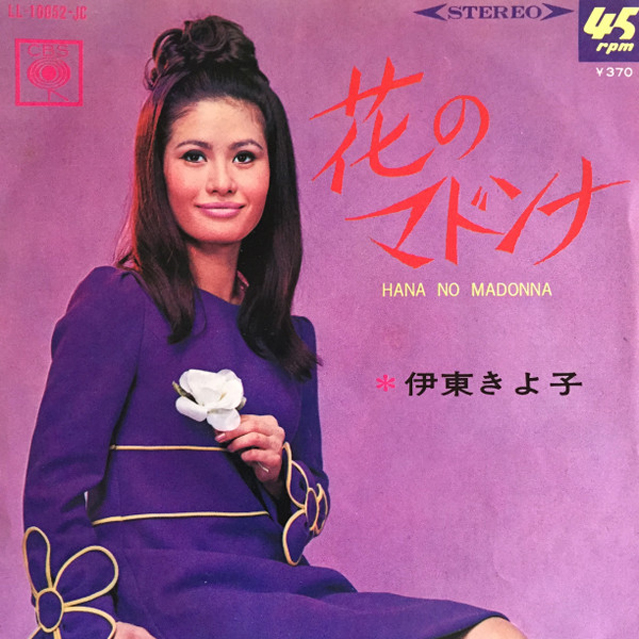

So there you have Kiyoko’s sweet, psychedelic love song release, and after a few listens, like a whispering haze, I’m sure it will seep delightfully into beating heart. I would love to be enlightened on anything more about this wonderful singer, from anywhere out there in the world.
– DJ del Piero
Kay Bell and The Spacemen – Scream Along With The Monster
Buena Vista Records – F-428 Released 1964
Track B – Scream Along (With The Monster)
Well it’s HALLOWEEN again, and that means it’s time to pull out some of my dearly beloved spooky records from under the bed! This year I’ve chosen to feature this incredible Kay Bell and the Spacemen track, because in my eyes it’s one of the absolute best if you’re up for spooks and frightful delights! EVERYBODY SCREAM!!!
Kay Bell was at one point, one half of the youthful and famous pop duo, The Bell Sisters, the other half being her big sister Cynthia Strother. Born in Kentucky, they have four sisters and one brother, and as performers the duo would adopted their mother’s maiden name of Bell. Cynthia 16, and Kay, being only 11, were discovered on October 31, 1951, singing “Bermuda” on a Los Angeles television program called “Peter Potter’s Search for a Song.” The song was released in 1952, it reached #7 on the Billboard charts and sold in the millions, and The Bell Sisters pretty much became a household name, particularly in the US.
They enjoyed a roller coaster ride of success, eventually releasing eleven records (22 songs) for RCA and hitting the charts again with “Wheel of Fortune” (#10). They appeared on many popular radio and television programs, including The Johnny Carson Show, The Frank Sinatra Show, The Perry Como Show and The Dinah Shore Show. They appeared some 14 times with Bing Crosby and Bob Hope and opened for Nat King Cole in Los Angeles and also worked with greats Kay Starr, Rosemary Clooney, Lucille Ball, Tony Curtis, Dean Martin, Jerry Lewis, Mel Torme. They took their act on the road (during school breaks) and performed in big cities including New York, Dallas, and Las Vegas.
They also made it onto the big screens, working on the movies Cruisin’ Down the River (Columbia, 1953), Those Redheads from Seattle (Paramount, 1953) and Les Brown Goes to Town (Universal).
Kay Bell would start venturing into solo projects around 1959, singing in ballrooms and performing and broadcasting on radio. In the early sixties, Kay worked with the Space Men (Johnny Schmidt and Sonny Anderson) and scored a residency at the Disneyland Space Bar (now known as Tomorrowland Terrace). She performed with them as many as 6 nights a week, even while attending Long Beach State College for her Bachelor of Arts degree in English. She recorded a single as Kay Bell & The Tuffs called Surfers’ Stomp in 1961, written by Schmidt and Anderson and released on Dot.
Kay performed on a couple of live television broadcasts from Disneyland in 1962, on what was a regularly Saturday night screening “Meet Me at Disneyland”, on the Tomorrowland theme episodes Swingin’ Through Space and Talent On Parade. In September 1963, Kay Bell and the Spacemen recorded live two tracks, Surfer’s Blues and Scream Along With The Monster, written by Kay Bell herself (and W. Anderson).
Scream Along With The Monster starts with a VERY familiar “Comin’ Home Baby” groove, which is fantastic, as many innocent listeners would believe they know what they are expecting, when I play this track. But the twist is quick, and Kay Bell is superb in her delivery, preparing you for with what you need to do when you hear green eyed monster’s horn! The energy becomes more frantic as the song progresses, and after two short versus, you can’t help but feel an obsessive need to join in with the screams! I love that this was recorded live! Surely they must have prepared the audience to give them their all, before they pressed record! It’s so much fun but just too quick, but then again, like a fast roller coaster ride, it can leave you out of breath! Surfer’s Blues starts as a bit of a Jazzy stroller but quickly unleashes into a bit of a grinding savage beast with raunchy chaos and beats! Kay really enjoys showing off her vocal skills on this one and it’s such a bonus to have it on this single!
Unfortunately this was the only release from Kay and her Spacemen, and it makes me wonder about all the fun that would be had, listening and dancing to all those live performances they all played together, in those years of the sixties.
Now it’s important I mention, everything I found about about Kay and Cynthia, and the Spacemen, is attributed to the Bell Sisters official website put together by their nephew, who has nicely packaged and categorize a great amount of articles, photos and timelines, he’s been able to unravel about his aunties. So please jump over and dig in, and find out so much more about these incredible talented ladies. There’s also a great FaceBook page with a heap of great images, memories and dedications (links below for both).
Scream Along With The Monster is the ultimate Halloween party track to have, but I really believe it’s just too good to play once a year, so if you are lucky enough to have a copy, people always need a good scream, so spread it out there!
Top Photo from Bell Sisters FaceBook page – Cynthia and Kay 1956.
Middle Photo from Bell Sisters FaceBook page – Kay Bell performing at The Space Bar (Tomorrowland Terrace) at Disneyland January 1965.
Lower Photo from Bell Sisters FaceBook page – Kay Bell and The Spacemen – performing at The Space Bar (Tomorrowland Terrace) at Disneyland.
Raffaella Carra – Chissa’ Chi Sei
RCA Italiana – PM 3581 1971
Track 1: Chissa’ Chi Sei
Here is a real fire cracker from Raffaella Carrà! After losing her just a short time ago (on 5 July 2021), I thought this would be a good time to post what I think is one of her best tracks! Shine on Raffaella!
Raffaella was definitely NOT obscure or unknown by any means, especially in Italy where she was adored for a lifetime. She oozed that Italian sassy-ness and bravado and was always a glamorous shining light whether singing on stage or on the screens as an actress or presenter. She was also appearing and performing up until a couple of years before her death, so there is plenty content on line about this wonderful woman, but here’s a brief run down I think you may find interesting.
Carrà was born on 18 June 1943 in Bologna to Raffaele Pelloni and Angela Iris Dell’Utri, her parents, however, separated shortly and Carrà spent most of her childhood between her mother’s bar and the ice cream shop in Bellaria – Igea Marina. She grew up watching the television programme Il Musichiere, a game show that required guests to sing, learning by heart the most popular songs. When she was only eight years old, she left the Romagna Riviera to continue her studies directly in Rome at the National Academy of Dance. At the age of 9, while walking with her mother in Rome and through a family friend, she met the director Mario Bonnard who cast her in his film Tormento del passato, in which she played the very young character of Graziella. At the age of 14 she dropped out of ballet classes.In 1952 she began her studies at the Centro Sperimentale di Cinematografia to study the art and technique of cinematography and film, until she graduated in 1960. Carrà landed a few smaller roles in a couple of films in 1958 and 59, but she really made her debut as a recognized actress in 1960 in the film Long Night in 1943.
SWORDS AND SANDALS: Carra’s film roles would follow with a handful of “swords and sandals” films, an Italian film genre also know as peplum films, a sub-genre of largely Italian-made historical, mythological, or Biblical epics, that attempted to emulate the big-budget Hollywood historical epics of the time, such as Ben-Hur, Spartacus and The Ten Commandments.
She would appeared in films, including Fury of the Pagans (1960), Atlas in the Land of the Cyclops (1961), Mole Men Against the Son of Hercules (1961) as Princess Salirah, Ulysses Against the Son of Hercules (1962), Pontius Pilate (1962) (with the dashing Cocteau star Jean Marais as Ponzio Pilato) and Caesar the Conqueror (1962) with Dominique Wilms as Queen Astrid. There’s not a lot of public images around, with Carrà in these roles for some reason. Maybe she didn’t look at this early stage of her career as her best work? I did not know about this path of Raffaella! Most these films are available on line and look like so much fun! I’ve booked marked them all and so looking forward to watching them!
MUSICALS, COMEDIES AND ACTION THRILLER FILMS:
Carrà soon landed opportunities to play more popular roles, in a few comedies, musicals and action films, such as 5 Marines Per 100 Ragazze (1961), The Terrorist (1963), The Organizer (I Compagni) directed by Mario Monicelli and starring Marcello Mastroianni (1963) and La Celestina P… R… (1965).
In 1965, Carrà moved to Hollywood after signing a contract with 20th Century Fox, following in the footsteps of her fellow artists Gina Lollobrigida, Sophia Loren and Virna Lisi, Carrà. She appeared in the film Von Ryan’s Express alongside Frank Sinatra, Edward Mulhare and Trevor Howard. But feeling homesick and not liking life in Los Angeles, she decided to return to Italy that same year, and would star in more “local” productions such as the french film Le Saint prend l’affût (1966), Il Vostro Super Agente Flit, an Our Man Flint parody (1966), Why Did I Ever Say Yes Twice? (1969), and the french thriller Cran d’arrêt (1970).
1970’S AND THE MUSIC: In 1970 Carrà participated as a guest actress on Io, Agata e tu, a TV show hosted by the great Nino Ferrer. It was here where she could really show off her singing and dancing talents, which rocketed onwards!
She also presented the musical contest Canzonissima 71, which featured some pretty glamorous fashion, some back breaking dance moves on amazing sets, and a incredibly talented and dynamic house band that played some wild compositions just as “out there”! Here she would she release her hit single “Ma che musica Maestro“. She would also host the Canzonissima 74 edition.
After her success on the Italian market, in 1975 Carrà made her first appearance in Spain when she performed in the variety show Señoras y señores. During these years Carrà concentrated more on her singing career, achieving success in countries including Spain, Germany, France, Holland, Belgium, England, Greece, and in particular Latin American countries.The world was becoming well aware of Carra! And there was no stopping her!
Carrà would release a good number of LP’s and singles in the seventies and did well out of them. Her first LP simply titled Raffaella, I’m just discovering is a rare beauty, and also includes this featured single, Chissa Chi Sei (Sookie Sookie). Many would recognise this immediately, as a cover of Steppenwolf’s “Sookie Sookie” from the first their self-titled studio album Steppenwolf, released in January 1968. And it likely is the most well know version. But in truth, the original version is from Don Covay & The Goodtimers, released in 1966 (later released in March 1967 just credited and released by Don Covay).
The song was co-written by Covay alongside Steve “The Colonel” Cropper, who was a big co writer for Stax and Atlantic, co-writing classic songs such as Knock On Wood, The Dock Of The Bay and In the Midnight Hour. This early version is gritty soul and tight, and a real dance floor number, and apparently Cropper plays guitar on the track. The Goodtimers had an incredible line up including Bernard Purdie on drums and Buddy Lucas on tenor saxophone!
Carra’s version is an absolute banger! Why? Well for starters it has Carrà singing it in Italian with her undeniable Carrà determination! Her energy along with the fiery production takes this song onto a far bigger dance floor! Great percussion throughout, with big horns and Hammond organs (sounding very Brian Auger-ish), this is the best version in my book! The great Paolo Ormi E La Sua Orchestra takes the credit for the arrangement, and if you’re into Italian big beat-psycho beat records of the seventies, you will recognize Paolo Ormi’s name associated with tracks like Spiaggia Libera, Cocco Secco and No No No, and also the rare LP releases of P.O.X. Sound 2 and Tastiere.
The LP also includes and amazing version of Foot Prints In The Moon by Johnny Harris Orchestra, titled Conta Su Di Me. This blew my mind! I have never heard a vocal version of this and I’m assuming Carrà wrote the lyrics. Although after a quick Google translate, I was a little disappointed the lyrics weren’t about anything to do with the moon, nor any space travel concepts. Composers Francis Lai and Liberace (I’m not kidding) would both release beautiful versions of the track also in the early seventies.
While many albums followed, and were very successful for Carrà….not a lot of tracks are to my taste to be honest. But she is fun to dig on line for, as there’s some pretty great performances, especially the live clips. She’s a joy to watch and had some great outfits! One absolute amazing performance is her pairing up with Adriano Celentano, singing the great Prisencolinensinainciuso, likely in 1972 or 73! There’s also a great clip of her singing Superman from her 1974 album Felicità Tà Tà, and I also suggest the great Italo disco track Dreamin’ Of You.
Carrà would continue to work in TV for many years, as an actress and presenter, well into the 80’s, 90’s and the 2000’s. She’d continue with her music path as well, and would appear again on euro vision, would do support benefit gigs and kept releasing records up until 2021. In October 2020, the musical film Explota Explota, based on Carrà’s songs and directed by Uruguayan Nacho Álvarez, was released in Spanish cinemas, a country where she was very much love by for a big part of her life. Carrà died in Rome on 5 July 2021, at the age of 78
Other notable Sooki Sooki covers (all pretty great)…
Roy Thompson 1966
The Primitives 1967
Ricardo Ray Orchestra 1968
Davy Jones and the Voodoo Funk Machine 1968
Tina Britt 1969
Etta James- from her Come A Little Closer 1974
Here’s some great clips from Canzonissima 1971
And here she is doing Chissà chi sei…
Wanda Jackson – Fujiyama Mama

 Capitol 7P -73 JAPAN – Year 1958
Capitol 7P -73 JAPAN – Year 1958
Well for this post it was actually not too difficult to find some strong reference and facts (which is a nice change), for this featured artist who is the dazzling Wanda Jackson. The difficulty this time was instead, trying to chose which 7″ to feature, as she has just so many that thrill me! I’ve decided to go with the glorious Japanese picture covered dancer Fujiyama Mama.
 Wanda Lavonne Jackson was born on October 20, 1937, to Tom Robert Jackson and Nellie Vera Jackson, in Maud, a small town on the outskirts of Oklahoma City. Her father, who himself was a country singer, moved the family to Bakersfield, California in 1941, in hopes of a better life, by escaping the poverty created by the Dust Bowl during the Great Depression. He was also a guitar player and a fiddle player, but in a time of deep and sad depressing surrounds, once little baby Wanda came along, he couldn’t continue with his music.
Wanda Lavonne Jackson was born on October 20, 1937, to Tom Robert Jackson and Nellie Vera Jackson, in Maud, a small town on the outskirts of Oklahoma City. Her father, who himself was a country singer, moved the family to Bakersfield, California in 1941, in hopes of a better life, by escaping the poverty created by the Dust Bowl during the Great Depression. He was also a guitar player and a fiddle player, but in a time of deep and sad depressing surrounds, once little baby Wanda came along, he couldn’t continue with his music.
Wanda’s father noticed that his little young Wanda showed an interest in music, so he bought his only child that first musical instrument. Wanda recalls to Craig Morrison in the book Rockabilly The Twang Heard ‘Round The World, “When I was about six, he bought me a little guitar – it had the Uncle Sam hat on it because it was wartime. He put it in my hands and eventually I could reach around and he started teaching me chords”. He gave her lessons, taught her plenty of Jimmie Rodgers songs, and encouraged her to play piano, and in addition, he took her to see such acts as Tex Williams, Spade Cooley, and Bob Wills, which left a lasting impression on her impressionable young mind.
Tom moved the family back to Oklahoma City when his daughter was 12 years old. In 1952, she won a local talent contest and was given the prize of her very own 15 minute daily show on KLPR. The program soon after extended her spot to 30 minutes, which lasted throughout Jackson’s high school years. It was through this radio exposure that Jackson was discovered by country star Hank Thompson, who invited her to sing with his band, the Brazos Valley Boys. She began performing with them on weekends.
In 1954, she recorde d the single You Can’t Have My Love, a duet with bandleader Billy Gray, which hit No. 8 on the country charts. Thompson tried to get her signed with Capitol Records, but Ken Nelson, a company producer, said “Girls don’t sell records,” so Jackson signed with Decca instead, recording a good batch of singles for the label between 1954 to 1956.
d the single You Can’t Have My Love, a duet with bandleader Billy Gray, which hit No. 8 on the country charts. Thompson tried to get her signed with Capitol Records, but Ken Nelson, a company producer, said “Girls don’t sell records,” so Jackson signed with Decca instead, recording a good batch of singles for the label between 1954 to 1956.
Jackson insisted on finishing high school before hitting the road, and when she did, her father became her road manager and traveled by her side. While her mother stayed back and continued to work, somehow on top of that, she found time to make and help design Wanda’s stage outfits. “I was the first one to put some glamour in the country music…fringe dresses, high heels, long earrings,” Jackson said of these outfits. When she first toured in 1955 and 1956, she was placed on the Ozark Jubilee tour that featured many up and coming acts including Elvis Presley. The two hit it off almost immediately and actually dated for a brief time. Jackson said it was Presley, along with her father, who influenced and encouraged her to sing rockabilly.
In 1956, Jackson finally signed with Capitol, and one of her first 45’s has one of my favourite rockabilly B-sides Hot Dog! That Made Him Mad. It’s a cracker! The next year Jackson cut the rockabilly hit Fujiyama Mama, penned by Earl Burrows. Jackson told country music expert Rich Kienzle that she first became aware of the inflammatory tune when she heard R&B artist Annisteen Allen‘s 1954 version playing on a juke box when she was still in school in 1955. Jackson recalls that she “just flipped over it.” Burrows’ lyrics demonstrate that the bombings in Japan a decade earlier, were still viewed as being an impressive display of American might, without any consideration given to the moral implications of the devastating destruction which was unleashed onto the enemy. It is only now that I’m featuring this song (this Japan pressing comes with the lyrics…if you’re lucky) and as I read the lines, do I wonder how this song could have been taken so lightly, and how would it go down today. Sensitivity versus tongue in cheek. In the end, it’s really just a damn good dance floor country stomper, with some very fiery vocals, sexy attitude and flammable one liners.
 I’ve been to Nagasaki, Hiroshima too!
I’ve been to Nagasaki, Hiroshima too!
The things I did to them baby, I can do to you!
I drink a quart of sake, smoke dynamite!
I chase it with tobbacy and then shoot out the lights!
Well you can talk about me, say that I’m mean!
I’ll blow your head off baby with nitroglycerine!
Well you can say I’m crazy, so deaf and dumb!
But I can cause destruction just like the atom bomb!
‘Cause I’m a Fujiyama Mama
And I’m just about to blow my top!
Fujiyama-yama, Fujiyama!
And when I start erupting,
Ain’t nobody gonna make me stop!
Ironically, the song was a major hit in Japan and Jackson was treated like a dignitary when she toured there briefly in 1959. There are a few other versions of Fujiyama Mama that are totally enjoyable, one in particular released just after Allen’s version in 1955, by the very cutesy Eileen Barton, that has absolutely nothing wrong with it at all! For a punkish version, check Pearl Harbour‘s spin from 1981, and for something quite cheeky and off beat, go to Petty Booka‘s take, released in 1996, which sadly isn’t available on a 7″.
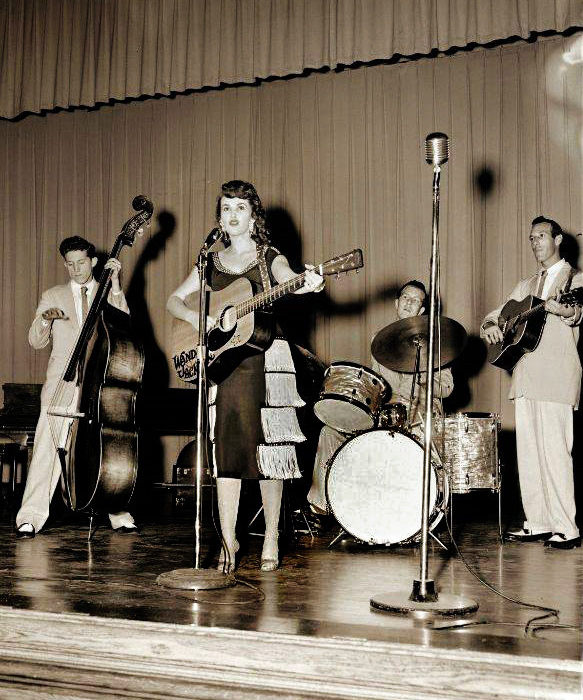 Jackson’s relationship with Capitol lasted until the early ’70s and in that time she released some “must have” 7 inches. Hot ones that I would suggest you add to your collection (as if you don’t already have them) are… the 1961 release Funnel of Love, B side to Jackson’s major country-pop single Right Or Wrong, the remarkable and favourite popcorn number Whirlpool from 1962, and the Elvis cover Hard Headed Woman which you can find on a french and Aussie 45 if you dig deep enough (likely pressed 1961). Another popular cut would be Let’s Have a Party, yet another Elvis cut, which was a U.S. Top 40 pop hit for her in 1960, after which she began calling her band the Party Timers. There’s also the fiery, violent My Big Iron Skillet from ’69, which humorously (perhaps) threatened death or assault for cheating on a spouse, made her a top 20 hit!
Jackson’s relationship with Capitol lasted until the early ’70s and in that time she released some “must have” 7 inches. Hot ones that I would suggest you add to your collection (as if you don’t already have them) are… the 1961 release Funnel of Love, B side to Jackson’s major country-pop single Right Or Wrong, the remarkable and favourite popcorn number Whirlpool from 1962, and the Elvis cover Hard Headed Woman which you can find on a french and Aussie 45 if you dig deep enough (likely pressed 1961). Another popular cut would be Let’s Have a Party, yet another Elvis cut, which was a U.S. Top 40 pop hit for her in 1960, after which she began calling her band the Party Timers. There’s also the fiery, violent My Big Iron Skillet from ’69, which humorously (perhaps) threatened death or assault for cheating on a spouse, made her a top 20 hit!
Jackson’s popularity bounced back and forth between country and rockabilly; she did this by often putting one song in each style on either side of a single. This is certainly the case with the flip of Fujiyama, which has the slow country ditty No Wedding Bells For Joe. As rockabilly declined in popularity in the mid-1960s, she moved to a successful career in mainstream country music with a string of hits between 1966 and 1973, including Tears Will Be the Chaser for Your Wine, A Woman Lives for Love and Fancy Satin Pillows.
 Wanda was a big attraction in Las Vegas from the mid ’50’s into the ’70s, and toured regularly, and in fact still does. She married IBM supervisor Wendell Goodman in 1961, and instead of quitting the business, as many women singers had done at the time, Goodman, like a good man, instead gave up his job in order to manage his wife’s career. Jackson followed Kitty Wells‘ lead as only the second country female vocalist to have her own syndicated television show, Music Village, from 1967 to ’68.
Wanda was a big attraction in Las Vegas from the mid ’50’s into the ’70s, and toured regularly, and in fact still does. She married IBM supervisor Wendell Goodman in 1961, and instead of quitting the business, as many women singers had done at the time, Goodman, like a good man, instead gave up his job in order to manage his wife’s career. Jackson followed Kitty Wells‘ lead as only the second country female vocalist to have her own syndicated television show, Music Village, from 1967 to ’68.
Obviously I’ve only touched here, on the talent and the star quality that is Wanda Jackson. Don’t be surprised if she turns up here again with another smokin’ 7″, cause as I said, she was packin’ them!
In 2009, Wanda Lavonne Jackson was inducted into the Rock and Roll Hall of Fame.
References and interests…
Rockabilly – The Twang Heard ‘Round The World – published 2011, Voyageur Press.
Maki Asakawa – Chicchana Toki Kara
Express Compact ETP-4277 Japan 1970

 Track 1 – B2 Chiccana Toki Kara
Track 1 – B2 Chiccana Toki Kara
Track 2 – A1 Yoru Ga Aketara
Maki Asakawa was a born in Ishikawa Prefecture, January 27, 1942. After graduating high school she worked as a civil servant for a short time before moving to Tokyo to pursue a far more inspirational career in music. She started by playing at United States military bases and cabarets, where she refined her style, which she says was largely influenced by Blues queens such as Billie Holiday and Mahalia Jackson.
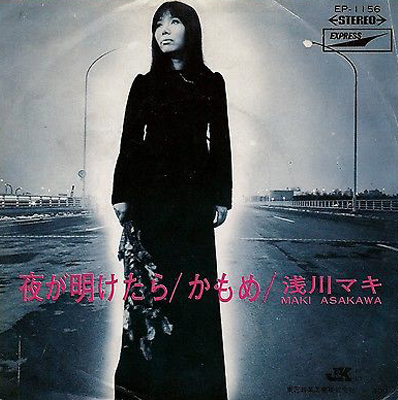 In 1967 Asakawa made her debut recording, releasing Tokyo Banka with B side Amen Jiro on Victor. In 1968, Asakawa got her big break when she appeared for three days running at the Shinjuku underground theater known as Sasoriza, a project of underground playwright Shuji Terayama. She soon signed with Toshiba, and by the next year had released the very, VERY cool and slick Yo ga aketara (At the Break of Dawn) and Kamome (Gull) on Toshiba’s subsidiary Express label.
In 1967 Asakawa made her debut recording, releasing Tokyo Banka with B side Amen Jiro on Victor. In 1968, Asakawa got her big break when she appeared for three days running at the Shinjuku underground theater known as Sasoriza, a project of underground playwright Shuji Terayama. She soon signed with Toshiba, and by the next year had released the very, VERY cool and slick Yo ga aketara (At the Break of Dawn) and Kamome (Gull) on Toshiba’s subsidiary Express label.
1970 saw this featured Asakawa release, which has as the B2 track, Chicchana Toki Kara. This wonderful, yet not easy to find EP, has to be my favourite from Maki, with it’s big beat drive, high energy horns and cinematic production. Every time I play this I get comments as to how hasn’t Tarantino used this track for one of his movies. It’s 70’s sex, has a good amount of sting, and would be the ideal punch for a strong femme fatale introduction. And having the slow swinging Yo Ga Aketara as the opening track makes this 7″ a real delight (that distant train at the end…I mean really, what a way to see out such a cool track). Just the thought of seeing this performed in a dark underground club of Tokyo by Maki and that time just does my head in. The smoke, the black, the neons and the distant traffic outside…not too difficult to visualize. But this wasn’t just a time for Asakawa’s musical exploration.
In 1971, Asakawa made her big screen debut when she played the stairway prostitute in Shuji Terayama’s experimental Throw Away Your Books, Rally in the Streets. It was the first film for poet-playwright Terayama, and it was about an angst-ridden teen who hits the streets after dealing with his dysfunctional family. This hard to find movie has a strong underground following due to it’s non-linear Avant-Garde vision and amazing pre-punk psychedelic soundtrack. Asakawa’s recording of Nemuru No ga kowai is included amongst the tracks, and can also be found on her 1971 Maki II album, which by the way also include covers of Gin House Blues and The House Of The Rising Sun. That great LP also happens to include the incredible psychedelic Govinda (there should be a link below)…such a stand out Asakawa composition! The next year in ’72, Asakawa would release Blue Spirit Blues, and again here her voice somehow feels so right within the warm minor chords.
 In 1973 Asakawa would this time hit the small screen on the dark Japanese TV Series Kyôfu Gekijô Umbalance. From what I can put together, she appeared in season 1 episode 7, and I’m almost certain the link below is the clip from that episode, where she plays herself singing Yo Ga Aketara, on a cinema screen in a dark seedy theater, and with the dark seedy characters to match.
In 1973 Asakawa would this time hit the small screen on the dark Japanese TV Series Kyôfu Gekijô Umbalance. From what I can put together, she appeared in season 1 episode 7, and I’m almost certain the link below is the clip from that episode, where she plays herself singing Yo Ga Aketara, on a cinema screen in a dark seedy theater, and with the dark seedy characters to match.
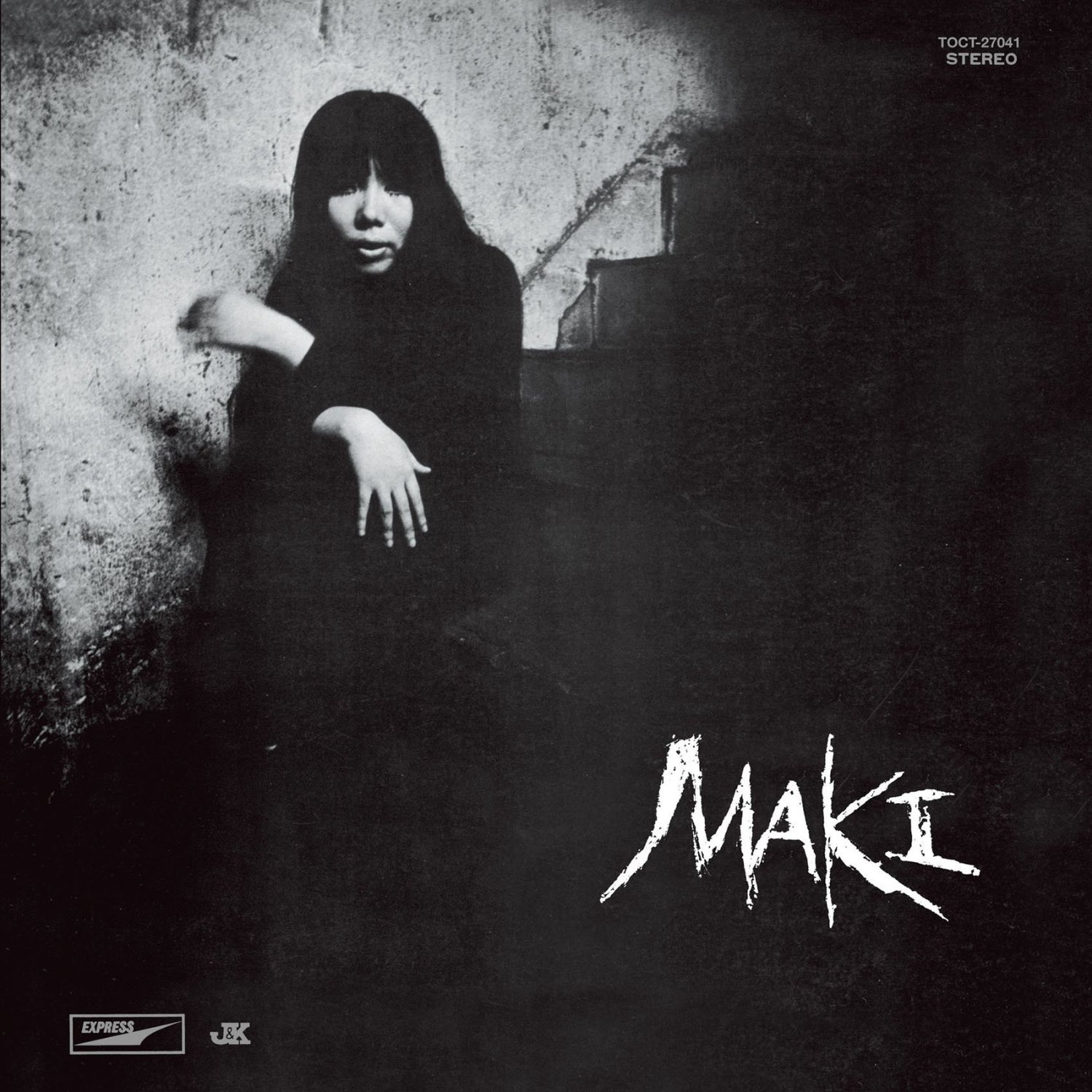 Over the next 30 or so years, Asakawa recorded quite a lot of records, but it wasn’t all dark moody blues and folk jazz. I discovered the Catnap album through a favourite blog, Interstellar Medium – Foriegn Lavish Sounds, which you should hit up, for a far more detailed look into the great album. Released in 1982, it’s a colourful, bold yet smooth collision of electronic jazz funk post punk plus, and for myself, it was so exciting to discover this side of Asakawa. The opening track Kurai Me Wo Shita Joyuu and also Shinkyoku B are real high lights, if I was forced to choose. This album holds up to quite high to today’s very standard standards in my opinion.
Over the next 30 or so years, Asakawa recorded quite a lot of records, but it wasn’t all dark moody blues and folk jazz. I discovered the Catnap album through a favourite blog, Interstellar Medium – Foriegn Lavish Sounds, which you should hit up, for a far more detailed look into the great album. Released in 1982, it’s a colourful, bold yet smooth collision of electronic jazz funk post punk plus, and for myself, it was so exciting to discover this side of Asakawa. The opening track Kurai Me Wo Shita Joyuu and also Shinkyoku B are real high lights, if I was forced to choose. This album holds up to quite high to today’s very standard standards in my opinion.
As Maki Asakwa grew older, she never stopped performing live. Just before an appearance on January 15-17, 2010 where she had a concert in Nagoya, she died of heart failure before the show could go on. She was 67.
References and inspirations…
Maria Dallas – Ambush
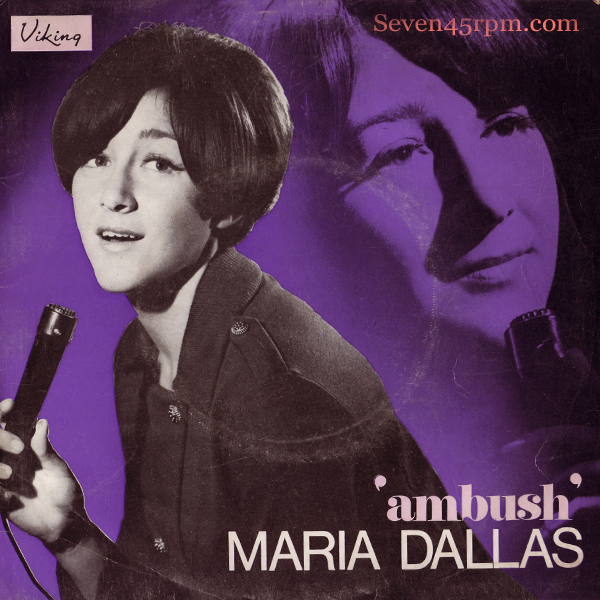
 Viking EP – Cat# VE-1001, (EMI) Australia Recorded 1967 Released 1968
Viking EP – Cat# VE-1001, (EMI) Australia Recorded 1967 Released 1968
Ambush (Side 2 Track 2)
I only just recently stumbled across this gem in a box of random rough 45’s in my favourite local record store, but somehow, I just knew there was going to be a little “something special” about it, so I grabbed it. When I got home, I polished it up, flicked the switch to 45 and placed the needle down. Yeah, it was alright, straight country beat…but as track 2 on 2 started up, a feeling inside told me to turn up the volume…and that something special was certainly affirmed! I had to find out more about Miss Dallas!
So I start to dig around for some history lessons on who I thought was certainly a Nashville singer, but to my surprise, I find out that she is in fact currently living here in the north of Australia, in Queensland. But that wasn’t the only surprise…she was actually born and breed in New Zealand!
And once again, I find that not a lot of information can be found on her, but I wil try and gather what I can, mash it all together, with hopefully some facts here and there.
Marina Devcich was born to a Croatian family, on April 14th 1946, in the provincial town of Morrinsville (in the Waikato region of New Zealand’s North Island) and was the second youngest of twelve children. She was gifted with a distinctive voice which you seriously could compare to say, Wanda Jackson, with a stir of Brenda Lee.
In 1964, Marina (wh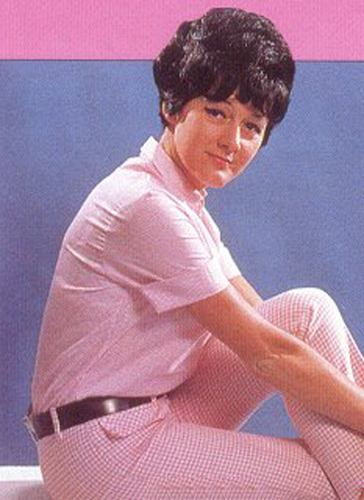 o was a hairdresser at that time) and Isabel Leigh won a Johnny Cooper talent quest in Morrinsville. Further solo performances with the Lew Manson Band around the Waikato area followed. One night in 1965, she was booked to appear in a Morrinsville hotel with Howard Morrison (who started up the very popular Howard Morrison Quartet with guitarist Gerry Merito) and Auckland bandleader Mike Perjanik (who formed The Mike Perjanik Band after departing The Embers, and would go on produce the “sound” for the NZ beat girls The Chicks, write hits for Dinah Lee and arrange for Ray Colombus).
o was a hairdresser at that time) and Isabel Leigh won a Johnny Cooper talent quest in Morrinsville. Further solo performances with the Lew Manson Band around the Waikato area followed. One night in 1965, she was booked to appear in a Morrinsville hotel with Howard Morrison (who started up the very popular Howard Morrison Quartet with guitarist Gerry Merito) and Auckland bandleader Mike Perjanik (who formed The Mike Perjanik Band after departing The Embers, and would go on produce the “sound” for the NZ beat girls The Chicks, write hits for Dinah Lee and arrange for Ray Colombus).
Perjanik went straight back to Auckland to tell Viking Records’ chief Ron Dalton that he’d found his next star in the Waikato. Dalton decided to rename her Maria Dallas, and almost overnight the girl with the power packed voice found herself in an Auckland professional recording studio.
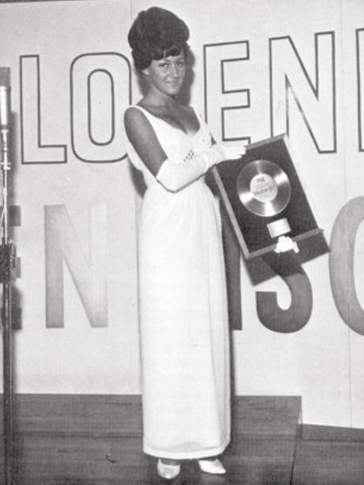 In ’66, Viking released a bunch of 7’s for Dallas including an EP titled Queen of the House (VE 224), which included a very oddly produced version of How Does That Grab You Darlin’, with very kooky keyboard backing. But it was her recording of Jay Epae’s Tumblin’ Down, that would bring her success! It in fact became a massive hit and it would be Maria’s signature tune. The song made it to number 11 on the national charts and was entered into the Loxene Golden Disc Awards, where it took first place!
In ’66, Viking released a bunch of 7’s for Dallas including an EP titled Queen of the House (VE 224), which included a very oddly produced version of How Does That Grab You Darlin’, with very kooky keyboard backing. But it was her recording of Jay Epae’s Tumblin’ Down, that would bring her success! It in fact became a massive hit and it would be Maria’s signature tune. The song made it to number 11 on the national charts and was entered into the Loxene Golden Disc Awards, where it took first place!
Tumblin’ does have a catchy pop quality to it, and it has grown on me. It is also included on this EP, but it certainly isn’t the star on this spinner as far as I’m concerned. That title goes to…well…the infectious title track…Ambush! With it’s big kick start, instantly we have fuzz guitar, searing keyboards, and killer cool backing vocals. And who doesn’t love a song that starts straight into it’s punchy chorus?! This track has got a lot of sass to it…that kinda Ann Margaret sass (well I think it does), and it’s relentlessness makes it a good dance floor shaker! And it looks like it made it to number 12 in Oz, in October of 1967!
Viking churned out six albums during 1966 and 1967, and a similar number of singles. None of the singles fared as well as Tumblin’, and despite it’s success, Maria never felt at home as a pop singer, so she would return to her country music roots. She moved to Australia in late ’67, before venturing off to Nashville where she recorded in the famous RCA Victor Studios with producer Felton Jarvis (who was working with Elvis at this period and almost until his death) and also with Chet Atkins.
Although singles were still released during her absence, New Zealanders had almost forgotten about her until she returned in 1970 with a song called Pinocchio, which went all the way to number 1 on the national charts. Viking capitalised by releasing another album in 1971 and a follow up in 1972, but Maria wasn’t able to reproduce her success after that. She would also release a few more singles on the Kontact label, in ’73, ’75 and even up to ’81.
Maria married an Australian an has lived here for many years. I would love to hear from anyone who knows how she’s doing!
Referencing sites and related links…
Janis and Her Boyfriends – Bang Bang

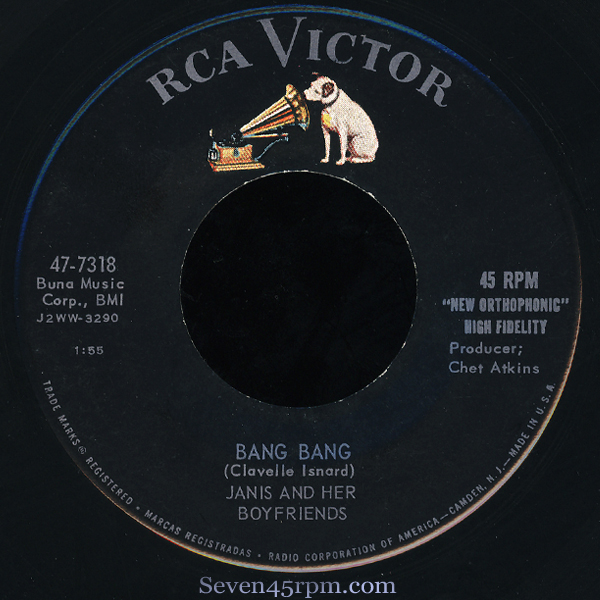 RCA Victor 47-7318 US Year 1958
RCA Victor 47-7318 US Year 1958
Janis Darlene Martin was born in Southerland, Virginia, just east of Danville, on March 27, 1940. With a stage mum on one side and a father and uncle who were musicians on the other, surely it was inevitable that her destiny was laid out as a musical performer.
By the age of six, the little lady had mastered basic chords on the guitar and began singing, and although the young Janis may have been small, she packed a voice that was loud and strong. At eight, she entered her first talent contest and scored a proud second place. For the next two years, she entered eleven contests over a three-state area, winning first place in each one…and one those talent shows had over 200 contestants that took four days of elimination.
By 11, Martin was playing and singing as a member of the WDVA Barndance in Danville, Virginia. From the barndance, she traveled with Glen Thompson’s band for two years and then went on the road with Jim Eanes, a former Starday recording artist.
In 1953, the teenager appeared at a Tobacco Festival with Ernest Tubb and Sunshine Sue. As a result of this appearance, Martin was invited to become a regular member of the Old Dominion Barndance in Richmond, Virginia.
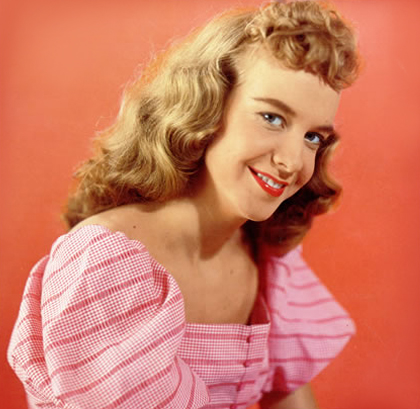 At that time, that stage show was the third largest in the nation, and included such stars as Jean Shepherd, Hawkshaw Hawkins, Sonny James, Martha Carson, and the renowned Carter Sisters who encouraged Martin to try for the “big time”. With two years of travels with the show, Martin would not only gain valuable show business experience, but also the realization that she now only lived for one thing – entertaining people.
At that time, that stage show was the third largest in the nation, and included such stars as Jean Shepherd, Hawkshaw Hawkins, Sonny James, Martha Carson, and the renowned Carter Sisters who encouraged Martin to try for the “big time”. With two years of travels with the show, Martin would not only gain valuable show business experience, but also the realization that she now only lived for one thing – entertaining people.
Two staff announcers at WRVA (the station that carried the barndance over the CBS network) were successful songwriters and wrote a song called Will You, Willyum (this was just at the birth of the fifties rockabilly music explosion). They asked Janis to sing it on the barndance for audience reaction, and also cut a demo tape of it which they passed on to their publisher in New York. When the demo tape arrived at Tannen Music in New York, the publisher not only accepted the song but rushed over to Steve Sholes of RCA Victor, so he could hear it. Sholes wanted to know who the vocalist was on the tape and called Richmond to find out. Janis was contacted and invited to Nashville to record the song on Victor Records.
So, at the age of fifteen, she became a recording artist, and that release would end up being her biggest career hit, selling a massive 750.000 copies! To add to that, on the flip Drugstore Rock And Roll, a song that Janis wrote herself, which you could easily say is her most well known song and is probably the most played in the current scene.
Now this was must have been all very exciting for Martin, who although was still relatively very young, had already felt really bored with the slow mainstream country songs she had be singing in the past. She’d already had the spell of R&B over whelm her even as a younger girl, but at that time in the fifties, she would found it difficult to follow that path, being a white girl.
In a interview with Bobby Tremble, Martin would remember…”I would go up the road…there was a black church right up above my house…my little cousins wanted to play on Sundays and I would want to go up and lay in the weeds and listen to them sing”. She goes on to say…”It was that soul, it was that rhythm….and when I heard it…I said that is my music”. Martin and accompaniment were determined to find a new sound however, so they combined what you would then call hillbilly music with rhythm and blues…and this was all part of the birth of rockabilly music…which would grow like a beast and change many lives.
But Martin recalls just how tough it was for those first ladies, who were breaking out into this new crossover wave, which would include Wanda, Brenda Lee and of course Charline Arthur (who was the first female singer in country music to perform in pants, and she supposedly used the extra freedom to prowl the stage). There was some nasty slander coming from some of the men at the time, accusing Martin of being spawned from the devil, but the barefooted ponytail teen would not let that get in the way!
This was all happening at the time when Elvis Presley was the biggest rock singer in the country, who also happened to record for RCA Victor. Presley and RCA were so impressed with Janis’ delivery of a song, that Janis was given permission to use the title of “the Female Elvis Presley.”
Bu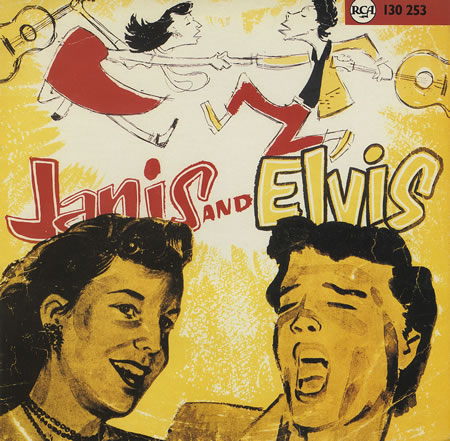 t some of the publicity rebounded for Janis as fans felt she was hooking her style as a means of exploitation. And although they both used the same session musicians and shared the same country-R&B interests, Martin never saw the Memphis Flash perform until he made it to national television. By that time she had independently developed her own amazingly similar performing style which was well established and locked down. Additionally, she only met Elvis twice, both times very briefly, with hardly a word exchanged. The two found themselves converging on a similar point.
t some of the publicity rebounded for Janis as fans felt she was hooking her style as a means of exploitation. And although they both used the same session musicians and shared the same country-R&B interests, Martin never saw the Memphis Flash perform until he made it to national television. By that time she had independently developed her own amazingly similar performing style which was well established and locked down. Additionally, she only met Elvis twice, both times very briefly, with hardly a word exchanged. The two found themselves converging on a similar point.
There was a 10″ Ep release titled Janis And Elvis (RCA-T31,077) which included 4 tracks from Martin as well as 4 tracks from the King himself, however it seems it was was pulled only 2 days on the market! And all because Elvis’ manager, Colonel Tom Parker didn’t want Janis’ name printed in front of Elvis’ name! Of course this record is worth a heap!
Eventually Martin was not only accepted, but would be in constant demand for TV, radio and stage appearances all over the US, and would appear on the Tonight Show, American Bandstand and Ozark Jubilee. She did her first road tour with Hank Snow and went on other tours with many greats including Johnny Cash and Carl Perkins.
 Martin was voted the Most Promising Female Artist of 1956 at the annual disc jockey convention and received the Billboard Magazine award on plaque. With much success behind her, she formed her own band called Janis Martin and the Marteens and began her travels in the U.S. and Canada, playing clubs and fairs. Apparently she also did a screen test for MGM, but not sure that pretty face made it on film…which would be a damn pity!
Martin was voted the Most Promising Female Artist of 1956 at the annual disc jockey convention and received the Billboard Magazine award on plaque. With much success behind her, she formed her own band called Janis Martin and the Marteens and began her travels in the U.S. and Canada, playing clubs and fairs. Apparently she also did a screen test for MGM, but not sure that pretty face made it on film…which would be a damn pity!
In 1957, she was chosen by RCA to become a regular member of the Jim Reeves show and traveled with him exclusively. The show went overseas to entertain the armed forces in Europe. On returning to the States, Janis appeared on the Today Show with Dave Garroway to tell of their experiences and to sing her latest record, My Boy Elvis. After this show, she was invited to appear at the Grand Old Opry.
The next year Janis and Her Boyfriends released this little beauty, Bang Bang. It’s credited to Clavelle Isnard, someone I can’t seem to find out too much about, other than he co wrote some tracks with Jimmy Holland…but never the less…this has to be my Janis Martin pick! Martin also loved this tune, as noted by Stephanie P. Lewin-Lane on her 2012 Sweet Nothings thesis…”I loved it because it moved. Bang Bang Bangitty Bang Bang…(laughing)…kinda vulgar for the ’50’s, ya know? Hidden messages and all of that, but I mean I liked the song, I didn’t think about the words then, I just liked the tempo, the tune of it, how it moved…” It certainly does move Miss Martin!
Everything seemed to be going well for Martin, well until 1958, when it was discovered that the teen had been secretly married to Tommy Cundiff, since 1956. Martin met the singer who was about six years older, when she was only 11 (they both played on the same show on WBTM), and the two started dating when she was 13. He would soon join the paratroopers but before being shipped out to Germany, he wanted to marry Martin and showed her a diamond ring. The two eloped when Martin was only 15…they married on January the 2nd of 1956. Martin actually didn’t record for RCA until March the 8th of 1956, so she didn’t tell the record company, nor did she mention it to her parents until about 3 months later. Tommy was off overseas only 8 days after their marriage and Martin wouldn’t get to see him for another fourteen months or so.
 Martin was on the USO tour in March/ April of 1957 and meet up with her husband in Frankfurt, who was able to get a 30 day leave so they could spend some time together. As a consequence from their a romantic interlude, Martin fell pregnant. The record executives were furious with Martin when they had finally found out about this, saying she had destroyed the innocent teenage image they worked so hard to sell her on…and was dropped by the label in short order. A pregnant teen they believed, would not be to good for marketing, especially upon learning that this innocent cute girl got hitched at 15.
Martin was on the USO tour in March/ April of 1957 and meet up with her husband in Frankfurt, who was able to get a 30 day leave so they could spend some time together. As a consequence from their a romantic interlude, Martin fell pregnant. The record executives were furious with Martin when they had finally found out about this, saying she had destroyed the innocent teenage image they worked so hard to sell her on…and was dropped by the label in short order. A pregnant teen they believed, would not be to good for marketing, especially upon learning that this innocent cute girl got hitched at 15.
For all of her early success, Martin was never able to sustain a rock & roll career, mostly because of her gender and the changing times. Her stage moves and lusty delivery appeared unseemly (or so people said, especially on the country circuit) in a girl, once the initial furor and enthusiasm for rock & roll quieted down. Her record company and management wanted her to keep pushing rockabilly in her stage act, while promoters doing the bookings preferred that she do straight country, and Martin found herself caught between conflicting currents.
Martin tried to keep a music career going and was courted by both King Records and Decca Records before signing with a Belgian-owned label called Palette, for which she cut four sides in 1960. She was on her second marriage by then, and husband number two (whom she later divorced) didn’t take well to her popular stage career, and persuaded her to leave show businesses.
 But by the seventies, Janis had had enough of being the “ordinary” little housewife and cook, and really missed the adoration that she once got from her fans. So she formed a new band…Janis and the Variations, which included her husband on drums. The band did become fairly successful in that they had constant work playing 3 state areas every weekend. However hubby wasn’t liking the journey as much as Martin, claiming it was interfering with their marriage. In 1973, he mistakenly gave her the ultimatum again, their marriage or the band! But this time…about 13 years after that first time he made such a statement, Janis gladly chose her music. Her son, who had been playing drums since the age of 7, gladly took the vacant spot and they would go on to tour Europe, where she encountered strikingly enthusiastic audiences, ready to embrace her as though it were still 1958. The band continued ’til 1982.
But by the seventies, Janis had had enough of being the “ordinary” little housewife and cook, and really missed the adoration that she once got from her fans. So she formed a new band…Janis and the Variations, which included her husband on drums. The band did become fairly successful in that they had constant work playing 3 state areas every weekend. However hubby wasn’t liking the journey as much as Martin, claiming it was interfering with their marriage. In 1973, he mistakenly gave her the ultimatum again, their marriage or the band! But this time…about 13 years after that first time he made such a statement, Janis gladly chose her music. Her son, who had been playing drums since the age of 7, gladly took the vacant spot and they would go on to tour Europe, where she encountered strikingly enthusiastic audiences, ready to embrace her as though it were still 1958. The band continued ’til 1982.
Martin passed away on September 3, 2007, after being diagnosed with terminal cancer which had spread all over her body. She had been suffering from severe headaches over the past several months so she found it necessary to cancel her recent booking at the Americana Festival in England. The headaches turned out to be stress related from all the grief she had to endure from losing her son Kevin who passed away in January that year.
She may have had a short career in recording music, but it was so fantastic, and so very important, as without a doubt she paved the way for future women rock singers!
DISCOGRAPHY
1956 – Drugstore Rock And Roll / Will You, Willyum RCA VICTOR 47-6491 35
Ooby-Dooby / One More Year To Go RCA VICTOR 47-6560
My Boy Elvis / Little Bit RCA VICTOR 47-6652
Barefoot Baby / Let’s Elope Baby RCA VICTOR 47-6744
1957 – Two Long Years / Love Me To Pieces RCA VICTOR 47-6832
Love And Kisses / I’ll Never Be Free RCA VICTOR 47-6983
All Right Baby / Billy Boy, Billy Boy RCA VICTOR 47-7104
1958 – Cracker Jack / Good Love RCA VICTOR 47-7184
Bang Bang / Please Be My Love RCA VICTOR 47-7318
1960 – Hard Times Ahead / Here Today And Gone Tomorrow PALETTE PZ 5058
1961 – Teen Street / Cry Guitar PALETTE PZ 5071
1977 – I’m Movin’ On / Beggin’ To You BIG DUTCH 2085
Rockin’ All Over The World / Live And Let Live BIG DUTCH 2086
Ep
1956 – Let’s Elope Baby/ Barefoot Baby
All I Can Do Is Cry/ St. James Infirmary RCA Victor (N.J.) DJ-38
1957 – Love Me To Pieces/ Two Long Years
Calypso Sweetheart/ Marriage And Divorce RCA Victor (N.J.) DJ-76
Just Squeeze Me (But Don’t Squeeze Me)/ My Confession
I Don’t Hurt Anymore/ Half Loved RCA Victor (N.J.) EPA-4093 [mono]
1978 – THE FEMALE ELVIS WITH THE JORDANAIRES : THE UNISSUED
William / Love Me Cha Cha / Love Me Love / Blues Keep Calling DOG GONE EP 81677
Lp
1959 – Janis And Elvis RCA T 31.077 (South African only)
Referencing and recommendations!
Stephanie P. Lewin-Lane Sweet Nothings
Cat Tales #20
Janis Martin Kickstarter
History of rock
Interview with Bobby Tremble
Marie Knight – Come On Baby (Hold My Hand)

 Okeh 4-7147 US Year 1962 Marie Roach was born June 1, 1925, in Sanford, Florida, and grew up in Newark. At the sweet little age of 5, she impressed the congregation at her parents church by singing the gospel song Doing All the Good We Can, and of course later became a soloist in her church’s youth choir.
Okeh 4-7147 US Year 1962 Marie Roach was born June 1, 1925, in Sanford, Florida, and grew up in Newark. At the sweet little age of 5, she impressed the congregation at her parents church by singing the gospel song Doing All the Good We Can, and of course later became a soloist in her church’s youth choir.
In 1939, the young lady first toured with Evangelist Frances Robinson, touring the national gospel circuit (she married preacher Albert Knight in ’41 but divorced later).
In 1946, she made her first recordings as a member of The Sunset Four (aka Sunset Jubilee Singers) for Signature and Haven (these labels would merge, but became defunct at the end of 1960 after being purchased earlier in the year by Roulette Records), and released a mighty fine handful of spiritual releases.
The now legendary guitar playing Sister Rosetta Tharpe, who was a major recording artist on the Decca Records label, and who many would say, brought gospel music to a broad audience, first heard Knight sing at a Mahalia Jackson concert in New York in 1946. Tharpe recognized “something special” in Marie’s contralto voice, and two weeks later, she showed up at Knight’s house in Newark, N.J., to invite her to go on the road with her.
Tharpe and Knight toured through the late ’40s, appearing in clubs, arenas, churches and auditoriums, sometimes acting out the parts of “the Saint and the Sinner”, with Tharpe as the saint and Knight as the sinner.
Together they had plenty of successes, including Up Above My Head, credited jointly to both singers, and reached # 6 on the US R&B at the end of 1948. The great Didn’t It Rain also did well and Knight’s solo version of Gospel Train reached # 9 on the R&B chart in 1949.
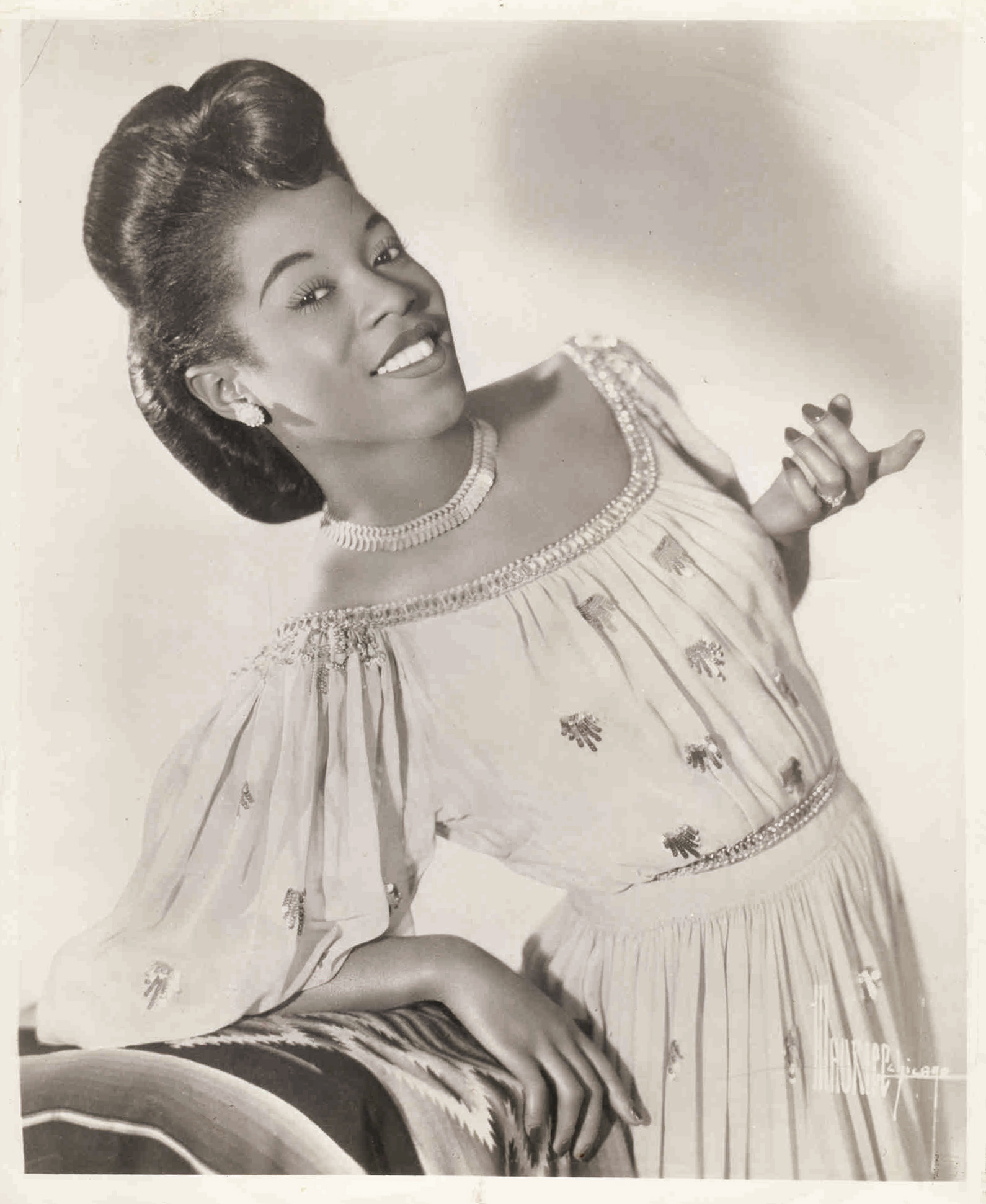 Knight left Tharpe to go solo around 1951, and released further more gospel recordings on Decca. But around April 1954, Marie Knight makes a change as she records straight ahead R & B songs I Know Every Move You Make and You Got A Way Of Making Love. These Rhythm & Blues tunes may have turned away a great many of Knight’s gospel fans, but she continues this move with a release during July of This Old Soul Of Mine and I Tell It Wherever I Go, and a November release of Trouble In Mind and What More Can I Do.
Knight left Tharpe to go solo around 1951, and released further more gospel recordings on Decca. But around April 1954, Marie Knight makes a change as she records straight ahead R & B songs I Know Every Move You Make and You Got A Way Of Making Love. These Rhythm & Blues tunes may have turned away a great many of Knight’s gospel fans, but she continues this move with a release during July of This Old Soul Of Mine and I Tell It Wherever I Go, and a November release of Trouble In Mind and What More Can I Do.
Both Knight and Tharpe’s friendship has stayed very strong and close, and in ’55, they get back into the recording studio together and release Stand and Storm on Decca, and together they score a two week stand at Chicago’s Black Orchid. In October, Knight lands a part of the lineup of the “Lucky Seven Blues Tour” along with Earl King, Little Willie John and other greats! Soon after the tour is over, she signs on for another all star touring show called the Rock ‘n’ Roll Jubilee which kicks off at L.A.’s Shrine Auditorium and again features star players including B.B. King, the classy Shirley Gunter, and sax cat Hal Singer.
In the spring of ’56, Knight follows her close friend Tharpe, from Decca to Mercury Records. While a couple more gospel releases sprouted once again, Knight decides to release another R&B beauty Grasshopper Baby (flip to Look At Me). In march of 1957 Mercury brings out the doo-wopping Am I Reaching For The Moon? and I’m The Little Fooler. In ’59, Knight and Tharpe record together again, and release Shadrack on Decca, which has to be one of my top picks from their almighty strong partnership!
1961 saw the release of the Knight bomb To Be Loved By You on Addit…you need to hear this if you don’t know it…amazing! That same year she recorded Come Tomorrow, released on Okeh, a tune which became much more famous after it was covered four years later by British rockers Manfred Mann.
And in ’62, she hits us with this…Come On Baby (hold my hand), again on the Okeh label. Quite slinky for Miss Knight, and you can’t help but feel this kinda tune has been waiting to burst out from her for some time. Another heart felt sound about love, but much more personal here than say spiritual. Not a lot can be found about this Roy Glover arranged session, and why this track is very rarely mentioned when reading up on Knight is a mystery to me, but it is well respected in the R&B community and on many collector’s want list for good reason.
Knight recorded and released a bunch more 45’s with various labels up til about 65, then slowly faded away from the scene. Her ripping version of Cry Me a River reached # 35 on the U.S. Billboard R&B charts in ’65, and was a powerful stamp to close an important chapter.
Knight remained friends with Tharpe, and helped arrange her funeral in 1973. In 1975, having given up performing secular music, she recorded another gospel album, Marie Knight: Today.
In 2002, Knight made a comeback in the gospel world, recording for a tribute album to Tharpe. She also released a full-length album, Let Us Get Together, on her manager’s label in 2007. She died in Harlem of complications from Pneumonia on August 30, 2009, but her legacy will live on…no doubt about it!
Jacqueline Taïeb – 7 heures du matin
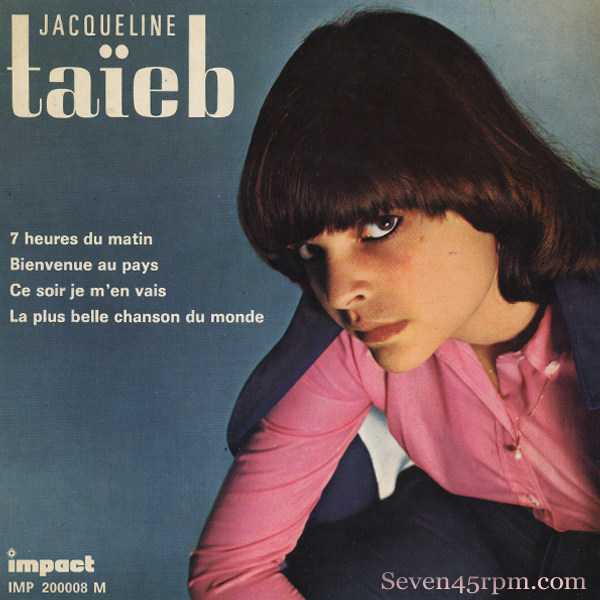
 Impact IMP 200008 M France 1967
Impact IMP 200008 M France 1967
Track 1 – 7 heures du matin Track 2 – Ce Soir Je M’en Vais
Born 1948 in Carthage, Tunisia, the young Taïeb arrived in France with her parents at age eight. Her father gifted her with a guitar at 12 (like every good dad should do) which she must have really connected with, because soon she would be composing her own songs. It wasn’t long before a talent scout would discover her while singing with friends. It was ’66, and what an exciting time it must have been for the big eyes of 18 year old singer-songwriter, scoring a contract with the record label Impact, and then being quickly whisked away off to London for her first recording sessions.
1967 saw a string of 7″ releases for the then 19 year old Jacqueline, but it’s this debut EP release (in January) that she is most well worshiped for. All four songs on the EP were composed by the young singer herself, which you have to remember for that time, was quite rare, as most female singers were expected to perform songs that had been written for them, or perhaps covers of other popular high selling hits.
Though the lead track, the almighty ye ye classic 7 heures du matin, was only a small hit at the time, it has gone on to become considered a classic of the French girl pop genre. It is the story of a young student waking up too early, at 7am, on a Monday morning, struggling with the thoughts of what the day will throw at her. She fantasizes about her boy crush Paul McCartney, helping her complete her homework, while tormenting on which sweater to wear for the day. Obviously a girl who is after trouble, the rebellious girl even considers playing her Elvis record loudly just to upset the neighbors. I mean really…how cute is that!?
It’s a simple song, but a huge dance floor monster! With it’s Steppin’ Stone garage power chords and it’s rebellious Elvis meets The Who attitude, it’s freakin’ impossible not to adore this one! And obviously very high in demand in the collectors circle. This track really brings back some great memories of the Sounds Of Seduction nights we once were fortunate to encounter here in Sydney in the 90’s, hosted by the great Jay Katz, (a friend who is responsible for introducing me to so much great lost European dance and film music of the sixties). And this song was also the trigger to the beginnings of my Ye ye obsession!
Update! A few years back I managed to get my hands on the elusive Australian issue of this masterpiece, with both 7AM and the flip side, which translates to Tonight I’m Going Home, sung in English! And finally getting a chance to upload. I love both these English renditions, even as a purist to the French originals! This issue has a catalogue date set to 1968.


W & G – WG-S-8124 Australia 1968
Side A – 7 am.
Side B – Tonight I’m Going Home
More Jacqueline Taieb 7″s to come as well a whole lot more Ye Ye!!!
Nina Simone – Come On Back, Jack
“She earned the moniker ‘High Priestess of Soul’ for she could weave a spell so seductive and hypnotic that the listener lost track of time and space as they became absorbed in the moment.” Official ninasimone.com.
As we all know, she was arguably one of the most important and influential women of the soul, blues and jazz genre, and I think the only real place to start a 45 collective journey is at the beginning. And it was in the early 60’s, a time when Nina was singing some of her most intimate and bluesy compositions of her career, when this little fiery monster surfaced amongst it all!
But first a little bit about Eunice Kathleen Waymon. She was born in Tryon, North Carolina on February 21st, 1933, the sixth child to a Methodist minister mother and a handyman and preacher father, and started playing piano by ear at the age of three. Her parents taught her right from wrong, to carry herself with dignity, and to work hard, which would in time mold her into the incredibly strong woman she grew up to be. She played piano in her mother’s church, displaying remarkable talent early in her life, but didn’t sing at that time.
Able to play virtually anything by ear, she was soon studying classical music with an Englishwoman named Muriel Mazzanovich, and quickly developed a lifelong love of Bach, Chopin, Brahms and Beethoven. After graduating from her high school, her local community raised money for a scholarship to study at Julliard in New York City before applying to the prestigious Curtis Institute of Music in Philadelphia. Eunice’s hopes for a career as a pioneering African American classical pianist were dashed when the school denied her admission. To the end, she herself would claim that racism was the reason she did not attend.
To survive, she began teaching music to local students, and also began singing in bars, which Eunice’s mother would refer that practice as “working in the fires of hell”. But quickly she attracted club goers up and down the East Coast with her unique jazz-blues renditions of Gershwin, Porter and Rodgers standards. And then Eunice Waymon became Nina Simone, taking the nickname “Nina” meaning “little one” in Spanish and “Simone” after the actress Simone Signoret.
At the age of 24, Nina came to the attention of Syd Nathan, owner of the Ohio-based King Records, and was signed to his Jazz imprint, Bethlehem Records. While at first Nathan had insisted on choosing songs for her debut set, he eventually relented and allowed Nina to delve in the repertoire she had been performing at clubs and was well known for. What I think is one of her most outstanding jazz compositions on Bethlehem is the B sided African Mailman released in 1960, and one you really need to check out!
Nina’s stay with Bethlehem Records was short lived and in 1959, after moving to New York City, she was signed by Joyce Selznik, the eastern talent scout for Colpix Records, a division of Columbia Pictures, founded in 1958. Her stay with Colpix resulted in some incredible recordings, including 9 albums, and some mighty fine 45’s including Forbidden Fruit and her beautiful version of I Got It Bad.
Produced by big band legend Stu Phillips, Come On Back, Jack is Nina’s response to Ray Charles dance floor bomb Hit The Road Jack, (written by rhythm and bluesman Percy Mayfield) which was released that same year! But while it does share a similar riff and beat, I have to say it’s Nina’s jam that has got Jack running the fastest and packs as much, if not more, dance floor impact. Unavailable on LP, this is a prized diamond hidden amongst so many jewels in Nina’s treasure trove that’s worth hunting for!
Finally, this post is only a very small chapter of this remarkable woman’s life and her recording career, but please stay tuned for future Simone posts here, as there’s certainly a few more 45’s that deserve to be spotlighted!
To find out so much more on this incredible woman’s highly influential life and music visit ninasimone.com.
And also….I Put A Spell On You: The Autobiography Of Nina Simone
The Kane Triplets – Theme from “Mission: Impossible”

 United Artists 50328 US Year 1968 The Kane Triplets were a three piece vocal sensation made up of the sweet identical triplets Lucille, Jeanne and Maureen Kane, and started their professional show business career very early in life. As children, they were discovered by the McGuire Sisters after performing on the Arthur Godfrey Talent Scout Show, and were asked to join with them in their act on the road and on several television shows. As you can imagine, these little ladies must have been so overly cute and wholesome, but from the footage that you can track down on the net, you cannot deny them of their harmony abilities!Reaction to the girls was amazing! The triplets established their own act and with their growing success, worked in very renowned venues throughout the country, and making Vegas their second home. They even got to work with huge celebrities like Tony Bennett, Andy Williams, Sergio Mendes, Smokey Robinson and the Temptations
United Artists 50328 US Year 1968 The Kane Triplets were a three piece vocal sensation made up of the sweet identical triplets Lucille, Jeanne and Maureen Kane, and started their professional show business career very early in life. As children, they were discovered by the McGuire Sisters after performing on the Arthur Godfrey Talent Scout Show, and were asked to join with them in their act on the road and on several television shows. As you can imagine, these little ladies must have been so overly cute and wholesome, but from the footage that you can track down on the net, you cannot deny them of their harmony abilities!Reaction to the girls was amazing! The triplets established their own act and with their growing success, worked in very renowned venues throughout the country, and making Vegas their second home. They even got to work with huge celebrities like Tony Bennett, Andy Williams, Sergio Mendes, Smokey Robinson and the Temptations
The ladies released a few 45’s but it was in 1968 when this little monster was unleashed to the world! Easily their most stin ging and thrilling recording, which really does give justice to Lalo Schifrin’s original 66′ master piece. While writing credits go to Fred Milano and Angelo D’Aleo of The Belmonts, I can’t tell you if this was in fact the first vocal release, but it’s by far the best I’ve heard. The fact that these now adorably blossomed but still innocent looking ladies are behind this big composition and production makes it even more tastier!
ging and thrilling recording, which really does give justice to Lalo Schifrin’s original 66′ master piece. While writing credits go to Fred Milano and Angelo D’Aleo of The Belmonts, I can’t tell you if this was in fact the first vocal release, but it’s by far the best I’ve heard. The fact that these now adorably blossomed but still innocent looking ladies are behind this big composition and production makes it even more tastier!
 The Kane Triplets were in show business for more than 20 years and made dozens of television appearances, but sadly another sad ending to this story learning that Jeanne Kane was found murdered at a Staten Island (New York City) commuter rail station parking lot, murdered by her ex-husband and retired sergeant John Galtieri in 2007. But on a nicer note, this song always get a great reaction on the dance floor when played and will keep these three little sisters shining on together for many more years.
The Kane Triplets were in show business for more than 20 years and made dozens of television appearances, but sadly another sad ending to this story learning that Jeanne Kane was found murdered at a Staten Island (New York City) commuter rail station parking lot, murdered by her ex-husband and retired sergeant John Galtieri in 2007. But on a nicer note, this song always get a great reaction on the dance floor when played and will keep these three little sisters shining on together for many more years.
The Pussycats – I Want Your Love
Track 1 – I Want Your Love Track 2 – The Rider
One of my top tens here and it just kills me that I cannot find out any real information on these garage grrls and this killer recording! It’s looking like this mighty four piece girl group may have only ever laid down four studio tracks in their career, including this release with The Rider on the flip, and also You Can’t Stop Loving Me (Columbia 4-43587), which I’m guessing was released that same year. You also get the strange and delightful Dressed In Black on that flip, made popular by The Shangrilas in ’66 on Red Bird.
 I Want Your Love, written by Tony Michaels, has all you could possibly want in my opinion. Opening with a dangerous blues riffing companionship with overdrive guitar and bar piano, insert seductive vocal “Hey you…. come here” and before you know it, you’re in the widow’s web. The first verse is playful and desperate, and the backing doo-wops and harmonies are starting to spin you in a spiral. We are now only 30 seconds in and the guitar gets dirtier and the build up, like a steep roller coaster climb, is making you nervous. You’re pretty much trapped by now, and can’t help feeling like that little mouse that kitty just won’t let die…all in the name of selfish pleasure perhaps. This track ticks all the boxes for me! It’s raw and driving, like good garage should be. It’s got great horns and pace, stomping percussion and stinging guitar, and of course those femme fatale vocals….innocent yet sultry, and even soulful! Great production from Michaels and killer arrangement by Artie Butler!
I Want Your Love, written by Tony Michaels, has all you could possibly want in my opinion. Opening with a dangerous blues riffing companionship with overdrive guitar and bar piano, insert seductive vocal “Hey you…. come here” and before you know it, you’re in the widow’s web. The first verse is playful and desperate, and the backing doo-wops and harmonies are starting to spin you in a spiral. We are now only 30 seconds in and the guitar gets dirtier and the build up, like a steep roller coaster climb, is making you nervous. You’re pretty much trapped by now, and can’t help feeling like that little mouse that kitty just won’t let die…all in the name of selfish pleasure perhaps. This track ticks all the boxes for me! It’s raw and driving, like good garage should be. It’s got great horns and pace, stomping percussion and stinging guitar, and of course those femme fatale vocals….innocent yet sultry, and even soulful! Great production from Michaels and killer arrangement by Artie Butler!
The Rider is more down tempo but still just as charming and has more of that Spector sound that I can’t get enough of! All four Pussycats recordings also came out as an EP (Portugal) through CBS in ’66 with a killer pic sleeve (above) with all band members. As always, I would love to know more about these elusive ladies and their recordings.
Sylvie Vartan – Ne T’en Vas Pas

 RCA Victor 86.019 France Year 1963
RCA Victor 86.019 France Year 1963
Prolific French ye ye singer Sylvie Vartan, who is actually Bulgarian, really does a nice swinging beat cover of the classic Comin’ Home Baby. Although it was originally recorded by the Bob Dorough Quartet in 1961 on Two Feet in the Gutter (Epic BA 17021) and composed by Ben Tucker (Bailey’s Pianist), it’s the ultra cool and hip Mel Torme version that most people know and love. Bob Dorough of School House Rock Fame added lyrics to the song and the vocal version became a Top 40 hit for the American jazz man, but I find Vartan’s more obscure version which was released in ’63, even more exciting!
Sylvie started her professional singing career while still at school, in her late teens, firstly with the hit song “Panne d’essence” (1961) alongside French rocker Frankie Jordan. Dubbed by journalists as “la collégienne du twist” (the twisting schoolgirl) she quickly started attracting a lot of attention, and it was only a matter of time that this young self confessed jazz/rock n’ roll fanatic, got signed up and began her illustrious recording career. In 1963, Paul Anka offered her “I’m watching”, her first international hit (Japan, Korea) which is the opening B side track of this EP. It’s adorably sweet and quirky with her broken English vocals, and holds a pretty respectful beat! That same year her dreams of being an aspiring actress came true, starring in the movie D’où viens-tu, Johnny? alongside french rock legend Johnny Hallyday, who she toured with in France and ended up marrying in 1965. Six of her thirty-one songs released in 1962/1963 became top 20 European hits and she became the darling of teen magazines and TV, so suffice to say this was an exciting and pivotal moment in her early career!
So back to Ne T’en Vas Pas! The back beat is strong and mean, as it should be, although I do wish it was pushed up in the mix a bit more as with the driving bass (you dj’s will be doing just that on your mixer) and I love the high energy modish Hammond solo. I have to say I always find French female vocal translations of standards or other, so much more attractive and desirable (this is not open for debate!) and Vartan’s approach on this makes it so ultra sexy and worthy! As far as I can tell, it doesn’t look like this recording was ever released on any other 7″ format other than the picture RCA EP. Maybe some foreign presses were released? Not too difficult to find and highly recommended!

 Also check out Sergio Mendes’ great Latin instrumental version of Comin’ home baby (Atlantic 45 2572) and Vartan’s great “Gimme some lovin'” cover Donne Moi Ton Amour!
Also check out Sergio Mendes’ great Latin instrumental version of Comin’ home baby (Atlantic 45 2572) and Vartan’s great “Gimme some lovin'” cover Donne Moi Ton Amour!
Laura Johnson – I know how it feels
Track 1 – I Know How It Feels Track 2 – Wondering If You Miss Me
This heart wrenching soul ballad is an absolute pearl and one I keep very close to my heart. A song to play late at night, with a stiff hard drink, on your own (well maybe with a pet friend), and not one that I play in public too often. A mysterious recording, certainly not an easy one to find particular specs on, so I had to visit my fav’ research web site Soulful Detroit once again for most of the info here.
Laura Johnson, an amateur singer from Detroit, who happened to work in the Correc-tone’s offices, paid for her own studio time and recorded these two stirring tracks at Wilbert Golden’s legendary Correc-tone studios. The self-penned “Wondering If You Miss Me”, and “I Know How It Feels”, which was written by infamous Popcorn Wylie and Motown’s Janie Bradford, and produced by Robert Bateman, were released in ’62 on Bob Shad’s New York Brent label. It’s likely that Correc-tone’s session musicians of that time, bassist James Jamerson, drummer Benny Benjamin and guitarist Robert White recorded on these tracks, but I can’t confirm that. I’m pretty sure that’s the incredibly beautiful “Andantes” backing her up here.
Laura also had a hand in writing a couple of gems cut by Marva Josie, including the excellent “Later For You Baby” which was released on Brent’s sister label,Time, also released in ’62.
“I Know How It Feels” was earlier released by The Satintones on Motown (the first band to ever record for that label) in ’61, then also with The Marvelettes on their Please Mr.Postman LP debut, that same year in November. Both versions are a delight in their own ways, but Johnson gets the badge of honor for me.
Seems not too many people out there really knew much more about this elusive artist and these remarkable isolated recordings. Sadly, it doesn’t look like Johnson was to ever record again, and with that remarkable tone, it’s the greatest shame!
France Gall – ZOZOI

 La Compaigne S-103 1970 France
La Compaigne S-103 1970 France
Born Isabelle Genevieve Marie Anne Gall 09.10.1947
I discovered this french chic many years ago searching through some old records in Paris, during my honeymoon. I couldn’t play my purchases until we returned back home, here in Australia, on the other side of the world, but when I finally did put down the needle to the vinyl, I was hooked on her…and still am to this day! What an amazing talent!
So much can be said about Gall, it’s fair to say the queen of the “ye ye” genre, but she is so much more. Having musical success from the age of 16, then soon collaborating with the legendary genius Serge Gainsbourg, and married to the late and great Michel Berger, this little lady, while quite prolific and mainstream, proved to be quite a power house vocalists, with a versatility that ranged from playful innocent teen pop, to scatty jazz and then more. Way too much to talk about in regards to this amazing woman here, but let’s just say her 60’s career was a bumpy ride. Although winning some worthy successful hits, a few of her recordings were marred with controversy and bad taste (thanks to Mr. Gainsbourg), not helping the young innocent and naive artist, and resulted in poor sales. But having said that, there is no Gall recording I don’t love, and I will have to do a special feature on her and her career some time soon.
So let’s talk ZOZOI! Easily the most sought after 45 of hers and rightly so. Released on La Compaigne, a new label for Gall, this is a contrast to her early sixties sweet pop and “yeye” recordings. Here, she is really turning on the seductive and steamy vocal chords in this latin bossa bonanza. Penned by her father-lyricist Robert Gall, recorded with the Brazilian master Pianist Cesar Camargo Mariano and his Sambalanço Trio, this is definitely new ground for her and is she just loving it. According to musicaltaste.com, while the band recorded in Brazil, the vocals were overdubbed later in France. Not an easy one to find in today’s market, but even rarer is the fantastico Italian vocal version, and I mean RARE! Sadly, I don’t have it, but really want it, so if you have a spare copy, I’ll be happy to take it! Released in 1970, it’s a must have! It’s French, it’s Latin, it’s Brazilian, it’s Tropicalia, and with that great horn section and that tempo, it’s as hot as this sweet little lady gets!
Music credits also go to Nelson Angelo.
Other France Gall recommendations…..
Le Temps du Tempo (1968), Jazz a gogo (1964) and Laisse tomber les filles (1964).
Highly recommended yeye website….


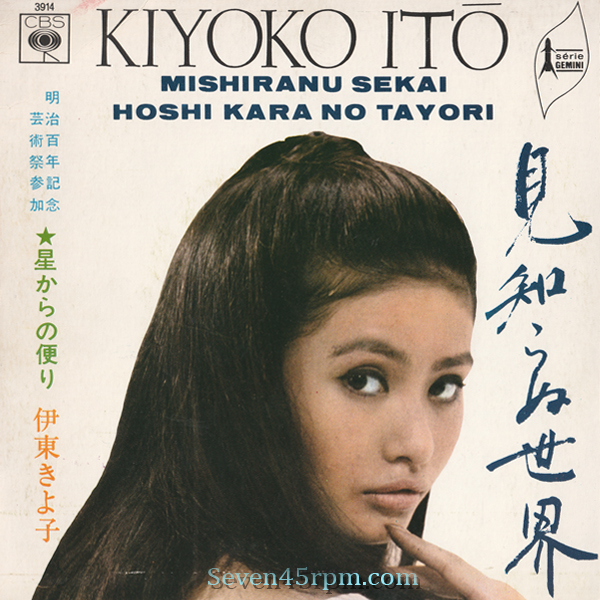

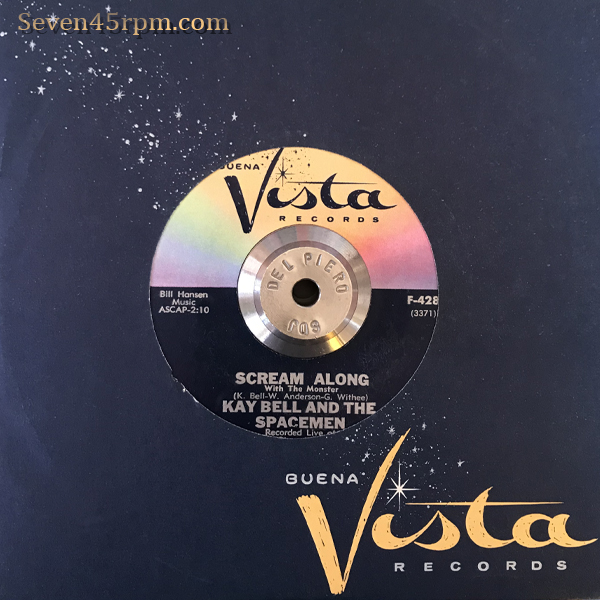




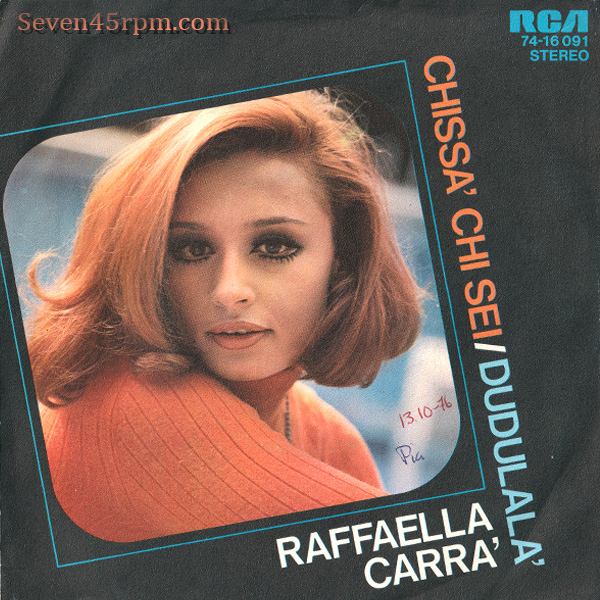
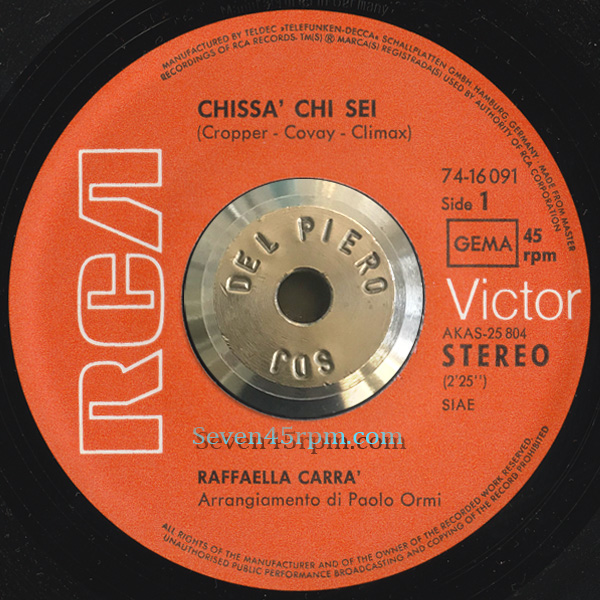
















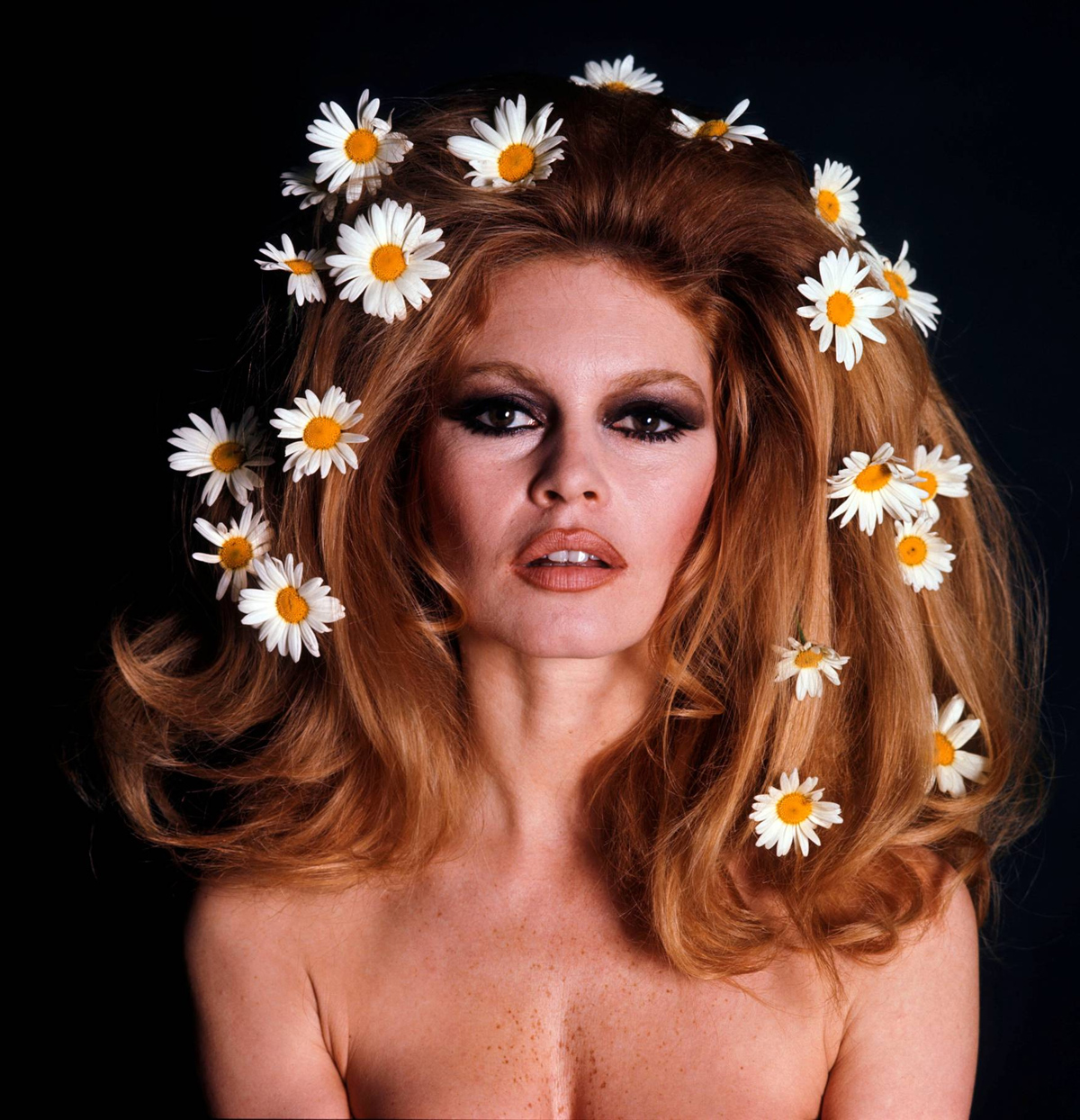
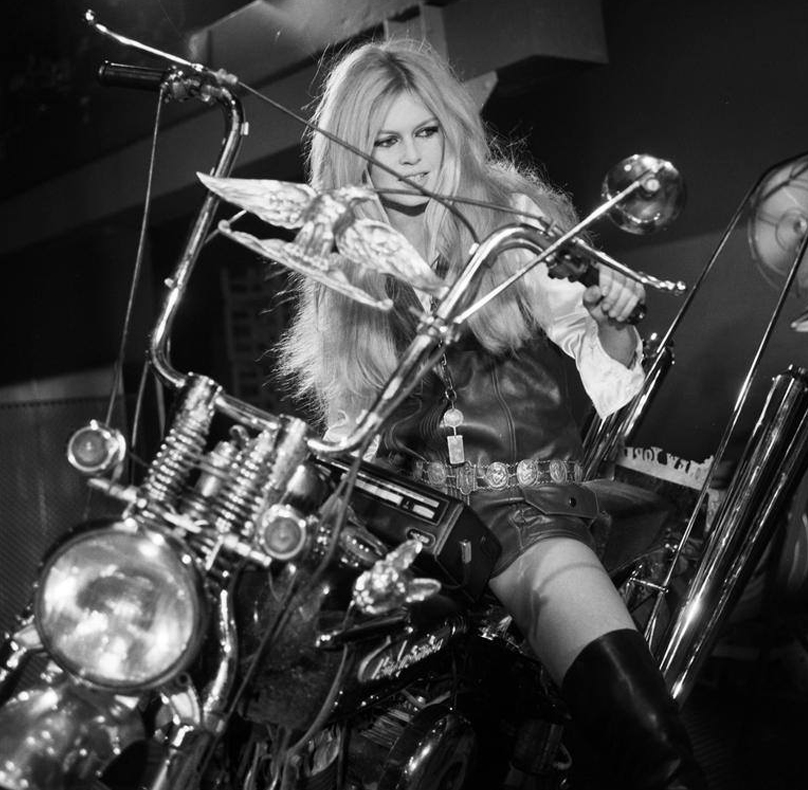









Recent Comments